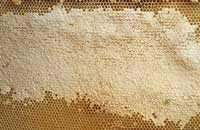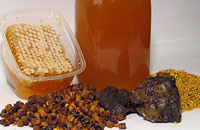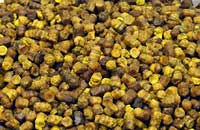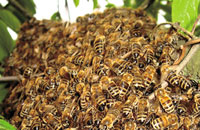УДК 638.157
![]() Чаще всего взрослые бабочки выходят из куколок вечером после 17 ч и в течение ночи. С наступлением темноты восковая моль покидает места отрождения. В самое темное время суток готовая к полетам бабочка улетает на поиски своего полового партнера.
Чаще всего взрослые бабочки выходят из куколок вечером после 17 ч и в течение ночи. С наступлением темноты восковая моль покидает места отрождения. В самое темное время суток готовая к полетам бабочка улетает на поиски своего полового партнера.
Цикл развития большой восковой моли [Galleria mellonella (Linnaeus, 1758) Latreille, 1809] включает яйцо, личинку, куколку, имаго. Большая восковая моль наносит пчеловодству значительный урон. В связи с этим пчеловоды должны проводить ряд профилактических мероприятий.
Для ликвидации большой восковой моли применяют сернистый газ, тимол, уксусную кислоту (80%), парадихлорбензол.
Ключевые слова: большая восковая моль, пчелиная огневка, яйца, личинки, куколки, воск, воскосырье, бабочки, феромоны, газовые обработки, тимол, уксусная кислота, парадихлорбензол, мелисса, приманки.
Р.Т.КЛОЧКО, С.Н.ЛУГАНСКИЙ, А.В.БЛИНОВ
Всероссийский НИИ ветеринарной санитарии,
гигиены и экологии —
филиал ФГБНУ ФНЦ ВИЭВ РАН
ЛИТЕРАТУРА
1. Beck S.D. Growth and development of the greater wax moth Galleria mellonella (L.) (Lepidoptera: Galleridae) // Thans Wis. Acad. Scie. Arts Letters. — 1960. — Vol. 49.
2. Bogdanov S., Indorf A., Charriére J.D., Fluri P., Kilchenmann V. Qualité des produits apicoles et sources de contamination // La Santé de l’Abeille. — 2002. — Vol. 191.
3. Bogdanov S., Kilchenmann V., Seiler K., Pfefferli H., Frey T., Roux B., Wenk P., Noser J. Residues of Para-dichlorobenzene in honey and bees // J. Apicul. Res. — 2004. — Vol. 43 (1):
4. Charriеre J.D., Indorf A. Protection of honey combs from wax moth damage. // Am. Bee. J. — 1999. — Vol. 139 (8).
5. Spangler H.G., Takessian A. Sound perception by two species of wax moths (Lepidoptera: Pyralidae) // Ann. Ent. Soc. Amer. — 1983. — Vol. 76.
6. Spangler H.G. Sound production and communication by the greater wax moth (Lepidoptera: Pyralidae) to maleproduced and artificial sounds // Ann. Ent. Soc. Amer. — 1985. — Vol. 78.
7. Williams. Insect: Lepidoptera (Months). In: Honey Bee Pests. — Predators & Diseases. — 1997.
СВЕДЕНИЯ ОБ АВТОРАХ:
Клочко Раиса Тимофеевна, канд. биол. наук, e-mail:
Луганский Сергей Николаевич, канд. биол. наук, e-mail:
Блинов Алексей Валерьевич, канд. вет. наук, e-mail:
CONTROL OF GALLERIA MELLONELLA ON APIARIES
R.T.Klochko, S.N.Luganskiy, A.B.Blinov
The greater wax moth [Galleria mellonella (Linnaeus, 1758) Latreille, 1809] life cycle consists of four stages: egg, larvae, pupa, imago. The greater wax moth may cause huge damage, so beekeepers should take a number of preventative measures. Sulfur dioxide, thymol, acetic acid (80%), paradichlorobenzene are used to kill wax moths larvae.
Keywords: great wax moth, great wax mouth, eggs, larvae, pupae, wax, wax source, butterflies, pheromones, gas treatments, thymol, acetic acid, para-dichlorobenzene, Melissa, baits.

Ловушка для роев
июнь 29, 2016
Роль пчеловодства в воспитании подростко…
март 15, 2019
Почему пчелы злые?
сен 23, 2014
Электродробилка
янв 17, 2021
Сушка заглубленного зимовника…
сен 4, 2024
Межрамочное расстояние…
янв 27, 2022
Пчелы с деформированными крыльями…
июль 19, 2016
Мед натуральный: проект нового националь…
нояб 13, 2016
Свечи на основе продуктов пчел в урологи…
сен 3, 2022
Новый путь борьбы с клещом…
июль 29, 2014
Сушка перговых сотов
апр 7, 2015
Пчелы грубости не терпят…
март 31, 2022















 Адрес редакции журнала "Пчеловодство":
Адрес редакции журнала "Пчеловодство":



